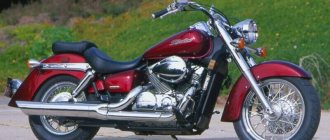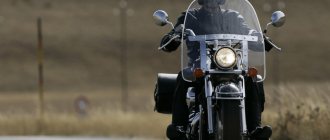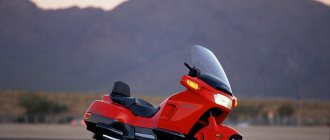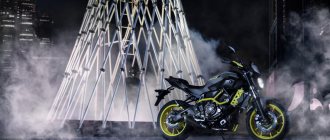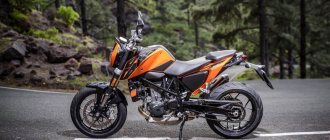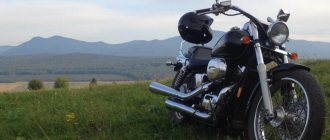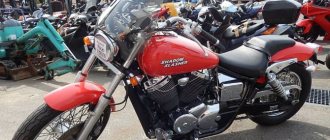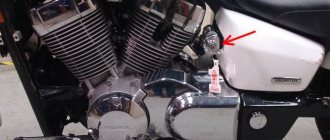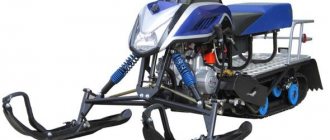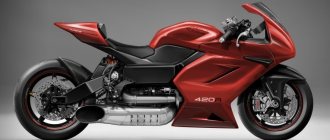Model history
Initially, the Shadow line, which the Japanese company offered to Americans, consisted of only two models - the Honda Shadow VT500C and Shadow VT750C.
These motorcycles appeared in 1983. The first of them was equipped with a 500 cc V-twin OHC engine, the second had a volume of 750 cc. cm.
This engine was also V-shaped, V-Twin SOHC.
The following year, after the Honda Shadow appeared on the market, American legislation increased duties on imported motorcycles larger than 700 cc.
As a result, production of the Shadow VT 750C model “stalled” for many years.
At the same time, the Shadow line itself expanded, and quite significantly.
During production, models with engines from 400 to 1100 cc were produced.
But the Shadow model with a 750 cc engine was remembered only in 2000, but this model was already aimed at the European consumer.
The Honda VT 750 Shadow, released in 1983, had the classic American cruiser style. The model was produced in two colors: black and caramel red.
Although, the red color is only a convention, since only the tank and side glove compartments were red on the motorcycle. The engine and frame were painted black.
Many elements of the motorcycle were chrome-plated: the front fork and fender, dashboard, headlight, exhaust pipes.
The engine of the motorcycle was equipped with water cooling, and the gas distribution mechanism implied the presence of three valves for each cylinder. The Shadow VT750C had a 6-speed gearbox, and the rear wheel was driven by a cardan.
In 2000, the successor to the first Shadow VT750C was a model with a slightly different name - Honda VT750DC Black Widow, aka “Black Widow”.
Although the name is different, the “widow” is still a Shadow VT750C, but with a slightly modified appearance. This motorcycle was already more like a “chopper”.
In 2007, another model with 750 cc engines appeared in the line, but the Shadow prefix was added to the name of these models.
First came the VT750DC Shadow Spirit, followed by the VT750DC Shadow Black Spirit. These models are still in production.
The differences from the first 750 cc Shadow among contemporaries mainly concern the appearance, although there are also changes in the technical part.
Now these motorcycles are already 5-speed, the power system has also changed - carburetors have been replaced with an electronic injection system.
But in general, the concept of the motorcycle itself remained the same - many chrome parts, including the engine, low seating, drop-shaped tank.
And only the VT750DC Shadow Black Spirit model is distinguished by almost no chrome, it is almost all black.
Price of Honda VT 750C2B Shadow Phantom based on sales advertisements
The maximum price of Honda VT 750C2B Shadow Phantom among the advertisements found is RUB 575,000*
The average price of Honda VT 750C2B Shadow Phantom among the ads found is RUB 390,000*
The minimum price of Honda VT 750C2B Shadow Phantom among the advertisements found is RUB 39,000*
Honda Shadow 750 Phantom 2011 in Perm
11/23/2020 RUB 470,000
Honda VT750 Shadow Phantom 2009 in Moscow
11/22/2020 RUB 415,000
Honda Shadow 750 Phantom in Novy Urengoy
11/19/2020 500,000 rub.
Honda Vt750 Shadow Phantom in Lyubertsy
11/17/2020 RUB 450,000
Honda Shadow VT 750 Phantom Black 2021 in Samara
11/10/2020 RUB 575,000
Honda Shadow Phantom VT750 in Kostroma
05.11.2020 360,000 rub.
Honda shadow 750 phantom 2021 in Perm
10.26.2020 460,000 rub.
Honda Shadow VT750 C2B Phantom, 2011 in Samara
10.20.2020 415,000 rub.
2011 Honda Shadow Phantom Black vt 750 c2b in Rostov-on-Don
10/20/2020 RUB 295,000
Honda Shadow VT750С2B Phantom 2013 in Sochi
09.29.2020 439,000 rub.
Honda vt 750 shadow phantom in Moscow
09.16.2020 RUB 350,000
Honda VT750 Shadow Phantom in Moscow
01/30/2020 421,000 rub.
Honda VT750 Shadow Phantom 2011 in Moscow
01/21/2020 RUB 390,000
Muffler Honda VTX 750 Honda Shadow Phantom in Perm
11/22/2019 39,000 rub.
Honda VT750 Shadow Phantom 2012 in Moscow
03.11.2019 RUB 390,000
Honda shadow phantom 750 in Vladivostok
10/07/2019 RUB 350,000
Honda VT750 Shadow Phantom 2012 in Moscow
09.26.2019 RUB 390,000
Honda Shadow Phantom 750 in Krasnodar
09.15.2019 RUB 399,000
Honda Shadow VT 750 Phantom in Sevastopol
09/12/2019 RUB 315,000
Honda Shadow Phantom 750 in Krasnodar
08/19/2019 RUB 399,000
Honda Shadow Phantom 750 Black in Yekaterinburg
08/12/2019 RUB 384,900
Honda Shadow 750 Phantom in Krasnodar
07/31/2019 420,000 rub.
Honda VT750 Shadow Phantom 2012 in Moscow
07/24/2019 RUB 390,000
Honda Shadow Phantom 750 in Kemerovo
07/02/2019 RUB 370,000
Honda Shadow 750 Phantom in Krasnodar
06/26/2019 Not specified
Honda shadow VT750C2B phantom in St. Petersburg
06/24/2019 RUB 390,000
Honda shadow 750 phantom in Dmitrov
06/16/2019 280,000 rub.
Honda VT750 Shadow Phantom in Moscow
06/16/2019 RUB 370,000
Honda Shadow VT750C2B Phantom in Kostroma
06/12/2019 RUB 370,000
Honda shadow phantom 750 g2011 in St. Petersburg
06/03/2019 400,000 rub.
Honda Shadow 750 Phantom in Krasnodar
06/02/2019 420,000 rub.
Honda shadow 750 phantom 2012 in Moscow
05/29/2019 RUB 360,000
Honda Shadow Phantom 750 in Krasnodar
05/27/2019 420,000 rub.
Honda Shadow 750 Phantom (Fantom) in Moscow
05/23/2019 RUB 350,000
Honda Shadow 750 Phantom in Sevastopol
05/22/2019 425,000 rub.
Honda VT750 Shadow Phantom in Krasnodar
10.24.2017 410,000 rub.
Honda Shadow VT 750 Phantom in Moscow
10.23.2017 469,000 rub.
Honda VT 750 Shadow Phantom in Moscow
09/26/2017 420,000 rub.
Honda Shadow VT750 Phantom in Nizhny Novgorod
08/21/2017 RUB 399,850
Honda VT750 Shadow Phantom in Kazan
08/09/2017 RUB 365,000
Selling Honda Shadow Phantom 750 2013 in Sevastopol
06/08/2017 400,000 rub.
Cruiser Honda Shadow Phantom 750 available in Abakan
03/15/2017 RUB 399,000
Honda Shadow VT750 Black Spirit phantom in Pyatigorsk
01/24/2017 390,000 rub.
Honda VT 750 C2 Shadow Phantom 2012 in Sevastopol
11/23/2016 470,000 rub.
Honda Shadow VT 750 Phantom in Moscow
10.20.2016 490,000 rub.
Honda Shadow VT750 Phantom in Nizhny Novgorod
08/14/2014 340,000 rub.
Honda Shadow 750 Phantom in Krylovskaya
07/30/2014 RUB 315,000
Honda VT 750 C2 Shadow Phantom in Krasnodar
07/29/2014 320,000 rub.
* Attention! Under the maximum, average and minimum of the Honda VT 750C2B Shadow Phantom motorcycle on this page, the average cost according to advertisements for sale on the Internet is indicated, without taking into account the year of manufacture, configuration and generation of the motorcycle model.
Comparison with analogues
In this case, we took the Yamaha Drag Star as an opponent for comparison. Quite often, when purchasing, future or current drivers have to make a choice between these models. Before the main differences between them are named, it is worth noting that both sides have many similarities.
Speaking about identity, we mean a similar style, engine parameters, where the torque and its direct power are almost the same. The dimensions and weight of the models vary slightly. The power supply is carburetor, the transmission is the same with the installation of cardans.
Comparing the transmissions, one could say that they are also the same, but when changing gears, a strong rumble comes from the Yamaha Drag Star, which cannot be said about the Honda Shadow. The main difference is the engine cooling system. Honda has liquid cooling, while the opponent has air cooling. The Drag Star's suspension features a monoshock absorber at the rear, while the other model has two classic shock absorbers installed there. One cannot help but mention the presence of two brake discs at the front of the Yamaha versus one of the Honda.
Transmission
The gearbox installed on the Honda CB 750 has the same characteristics as the engine, being reliable, long-lasting and quiet. Gear shifting is smooth and soft.
The weak point of the motorcycle is the gear shift shaft, which fails when dropped on the left side. Versions released for the Japanese market most often suffered from rapid clutch wear. Replacing this unit is complicated by the fact that it differs from those installed on European Honda CB 750 models, which makes it extremely difficult to find.
Release Features
Thus, in 1997, in parallel with the “American shadow” (Shadow 750 ACE), a domestic Japanese version was produced - a smaller engine, power, worse dynamics, but at a very affordable price. Users who saw the new creation were delighted: “Yes, this is a real liter, only less voracious.”
Since the documentation of the bikes went through the factories at the same time, they copied many details from each other. But there is one small detail due to which the motorcycles had different fates.
This is a prototype model. The younger one was planned to replace the Steed 400, and therefore took many parts from it.
The model existed until 2021, receiving restyling in the same years as the older one.
Prices
The Tuesday market price for it starts at $3,000. The price must include the cost of delivery from Japan and customs clearance. Since the model remained Japanese and at the same time production was gradually reduced, versions with mileage in the Russian Federation are not worth considering (editor’s opinion, that is, mine).
History
| History | ||
| Year | Country | Name/Frame/Engine |
| 1983 | Japan, North America | Name : Honda NV750 Custom, Honda VT750C Frame/Engine : RC14-XXXXXXX |
| 1986 | Japan | Name : Honda NV750 Shadow Frame/Engine : RC25-XXXXXXX |
| 1997 | Japan, Europe, North America | Name : Honda Shadow 750 ACE Code : VT750CV, VT750C2V |
| 1998 | Japan, Europe, North America | Name : Honda Shadow 750 ACE; Honda Shadow 750 Deluxe Code : VT750CW, VT750C2W; VT750CD |
| 1999 | Japan, Europe, North America | Name : Honda Shadow 750 ACE; Honda Shadow 750 Deluxe Code : VT750CX, VT750C2X; VT750CD |
| 2000 | Japan, Europe, North America | Name : Honda Shadow 750 ACE; Honda Shadow 750 Deluxe; Honda Shadow 750 Slasher Frame : RC44-XXXXXXX (ACE, Deluxe); RC48-XXXXXXXX (Slasher) Code : VT750CY, VT750C2Y, VT750C3Y; VT750CD |
| 2001 | Japan, Europe, North America | Name : Honda Shadow 750 ACE; Honda Shadow 750 Deluxe; Honda Shadow 750 Slasher (Black Widow, Spirit) Frame : RC48-XXXXXXX (Black Widow, Slasher), RC44- (Spirit) Code : VT750C21, VT750C31, VT750C1; VT750CD, VT750CD2, VT750CD31; VT750DC1, VT750DC |
| 2002 | Japan, Europe, North America | Name : Honda Shadow 750 Deluxe; Honda Shadow 750 Slasher (Black Widow, Spirit) Code : VT750CDA, VT750CDB, VT750CDC, VT750CDD; VT750DC, VT750DC2 |
| 2003 | Japan, North America | Name : Honda Shadow 750 Deluxe; Honda Shadow 750 Slasher (Spirit) Code : VT750CDA, VT750CDB, VT750CDC, VT750CDD; VT750DCA, VT750DCB |
| 2004 | Japan, North America, Europe, Australia | Name : Honda Shadow 750; Honda Shadow 750 Aero Frame : RC50-XXXXXXX Code : VT750C, VT750C4 |
| 2005 | Japan, North America, Europe, Australia | Name : Honda Shadow 750, Honda Shadow 750 Aero; Honda Shadow 750 Spirit Code : VT750C, VT750C5; VT750DCA, VT750DCB |
| 2006 | Japan, North America, Europe, Australia | Name : Honda Shadow 750, Honda Shadow 750 Aero; Honda Shadow 750 Spirit Code : VT750C, VT750C6; VT750DCA, VT750DCB |
| 2007 | Japan, North America, Europe, Australia | Name : Honda Shadow 750, Honda Shadow 750 Aero; Honda Shadow 750 Spirit Code : VT750C, VT750C7; VT750C2, VT750C2F, VT750DCA, VT750DCB |
| 2008 | Japan, North America, Europe, Australia | Name : Honda Shadow 750, Honda Shadow 750 Aero; Honda Shadow 750 Spirit Code : VT750C, VT750CA8, VT750C8; VT750C28, VT750C2F |
| 2009 | Japan, North America, Europe, Australia | Name : Honda Shadow 750, Honda Shadow 750 Aero; Honda Shadow 750 Spirit, Honda Shadow 750 Phantom Frame : RC53-XXXXXXX (Phantom); RC56- (Aero ABS) Code : VT750C9, VT750CA9, VT750CA, VT750C; VT750C29, VT750C2F9, VT750C2, VT750C2F |
| 2010 | Japan, North America, Australia, Europe | Name : Honda Shadow 750 Phantom (Spirit Black); Honda Shadow 750RS Frame : RC58-XXXXXXX (RS) Code : VT750C2B; VT750RS, VT750S (Japan) |
| 2011 | Japan, North America, Australia, Europe | Name : Honda Shadow 750, Honda Shadow 750 Aero; Honda Shadow 750 Phantom (Spirit Black); Honda Shadow 750RS Code : VT750C; VT750C2B; VT750RS, VT750S (Japan) |
| 2012 | Japan, North America, Australia, Europe | Name : Honda Shadow 750 Aero; Honda Shadow 750 Spirit; Honda Shadow 750 Phantom (Spirit Black); Honda Shadow 750RS Code : VT750C, VT750CA; VT750C2, VT750C2F; VT750C2B; VT750RS |
| 2013 | Japan, North America, Australia, Europe | Name : Honda Shadow 750 Aero; Honda Shadow 750 Spirit; Honda Shadow 750 Phantom (Spirit Black); Honda Shadow 750RS Code : VT750C, VT750CA, VT750CS; VT750C2, VT750C2F, VT750C2S (ABS); VT750C2B; VT750RS |
| 2014 | Japan, North America, Australia, Europe | Name : Honda Shadow 750 Aero; Honda Shadow 750 Spirit; Honda Shadow 750 Phantom (Spirit Black) Code : VT750C, VT750CA, VT750CS; VT750C2, VT750C2F, VT750C2S (ABS); VT750C2B |
| 2015 | Japan, North America, Australia, Europe | Name : Honda Shadow 750 Aero; Honda Shadow 750 Phantom (Spirit Black) Code: VT750CF + VT750CSF (C-ABS); VT750C2BF |
| 2016 | North America | Name : Honda Shadow 750 Aero; Honda Shadow 750 Phantom Code: VT750CG + VT750CSG (C-ABS); VT750C2BG |
| 2017 | North America | Name : Honda Shadow 750 Aero; Honda Shadow 750 Phantom Code: VT750CH + VT750CSH (C-ABS); VT750C2BH |
| 2018 | North America | Name : Honda Shadow 750 Aero; Honda Shadow 750 Phantom Code: VT750CJ + VT750CSJ (C-ABS); VT750C2BJ |
| 2019 | North America | Name : Honda Shadow 750 Aero; Honda Shadow 750 Phantom Code: VT750CK + VT750CSK (C-ABS); VT750C2BK |
Dimensions and weight
The geometric parameters of the Honda Shadow 750 have changed many times.
Because Shadow 750 is not the only model, but a whole series of modifications, and their external parameters also differ.
- Dry weight started from 211 (in 1983) to 246 (2018) kg.
- Equipped, with fully filled tanks - 225 (1983) to 263 (2018) kg.
And the dimensions also changed;
- The length changed 8 times from 2191 (NV750 Custom) to 2511 (Aero).
- Width - 10 times from 860 (NV750 Custom) to 940 (Aero).
- Height - 10 times from 1199 (NV750 Custom) to 1091 (Aero).
- Seat height - 760 (NV750 Custom) to 660 (Aero).
It is worth noting that Aero was developed in 2003; subsequent models had smaller dimensions. The exception is seat height. All earlier and later developments were larger.
For whom is it intended?
The motorcycle can be comfortable for people of different heights, depending on the modification.
Despite such variations in size, the engineers did not forget about the user.
The bike cannot be called universal, since they chose different modifications, but the developers managed to please everyone.
Description of design
The front wheel is covered on top by an oversized fender. The front fork has widely spaced stays. It itself is covered with chrome. The front lighting equipment consists of a small headlight and two small turn signals. A wide handlebar is installed at the top of the front fork.
Behind the steering wheel there is a small teardrop-shaped tank with a dashboard mounted on it.
The seat is not particularly large, has a stepped shape, and is designed for two people.
The hind wing is wider than the front wing, but short. At its end there is a brake light, as well as a platform for the number.
The frame is tubular, practically invisible; the radiator of the cooling system is located in front of it.
The power plant is a V-shaped, 2-cylinder with a carburetor power supply system, integral with the gearbox. An air filter is installed on the right side between the cylinders.
There are two exhaust pipes, one for each cylinder, and are located on the right side.
Gearbox – foot-switched, 5-speed. Transmission of torque to the rear drive wheel using a chain drive.
The rear suspension is pendulum type using two shock absorbers installed on the sides.
Design
Over the long history of production, the motorcycle was produced in various colors.
- The only detail that has not been changed is the frame, its design and geometry. Steel was used for rigidity, and a tubular design was used for lightness, controllability, and maneuverability.
- Depending on the year of production, the modifications had different sizes, separate technological solutions and features. But with the exception of a few models that differed only in color and body kit, these were different motorcycles with completely different settings.
- The suspension was done according to the standard. The front is on a telescopic fork, the rear is on a pendulum base. The fork used a conventional type, but over 30 years its travel decreased from 145 mm (NV750 Custom) to 117 mm (Aero and Phantom).
- A distinctive feature of the line is the presence of a pair of shock absorbers at the rear, but they also have a smaller travel stroke - from 105 mm to 80 mm.
Aero and Phantom are still on the production line and are available for order both new and used.
Exterior
The cruiser type requires a full set of lights, instruments, mirrors, and, sometimes, wind protection.
Front end
- The ACE (American Classic Edition) model, launched in 1997, received the windshield inherited from the first versions. It is large, curved to fit the body kit, and according to reviews, it protects the pilot well. In subsequent modifications it is removed. In addition, the model is distinguished by an elongated front fender and a large amount of chrome, typical of American motorcycles. The Slasher model (other names Shadow Spirit, Black Widow) 2000 and all subsequent ones are produced with a shortened wing.
The photo shows a 1997 Honda Shadow ACE 750 with its original windshield.
- The motorcycle's fork stays are bare. Only the Black Spirit modification receives small covers for the height of the wheel. Since the model is a close relative of the Aero (the only difference is the color), the covers can be installed independently.
- The head optics are repeated from version to version. Its role is played by a large round headlight. The turn indicators are placed on the fork legs and attached at its level. The headlight is surrounded by a symbolic body kit.
To fix the direction indicators, a special hollow bracket is used, inside of which the wiring runs.
- Thanks to the long pillars, the mirrors do not interfere between the rows, giving a relatively large picture. But the mount on the steering wheel, the angle of bend and the height of which changed from version to version, sometimes creates problems with the overview of the situation. The height of the steering wheel and the bend angle of the tube changed from purely chopper on the Slasher and Aero versions to the standard European one - Black Spirit.
Dashboard
We will describe this part using the Phantom model, which is still offered by the manufacturer. The set in front of the user is small. One large dial electronic speed indicator, and several lights.
The instrument panel of this bike is a dial speedometer located in the fuel tank trim.
The indicator is marked up to 190 km/h or 200 mph (for American models). There are 3 indicators scattered above it:
- high beam;
- rotation (1 piece for both directions);
- half a beer is not enough.
All three indicators are located on the plate that holds the front fork legs together.
In addition to them, 4 more lay under the speedometer glass;
- neutral;
- change the oil;
- engine temperature;
- check engine.
The mileage counter is also displayed in a separate window on the speedometer. It's digital.
On some models, the turn signal light is located under the speedometer glass.
The dial is located quite low, in the American style, it will not be easy to see the readings without lowering your head.
Back view
- The rear optics are presented in a complete set. The turns are taken outside the bike on their own racks. Stop and size are traditionally collected under one glass. It should be noted that most modifications have (!!!) a rear wing, and red signals are on it, so it will be difficult not to see them. But, although there is space for a luggage rack on the bike, there is none; installing some kind of hanging structure can cover the lights.
- The saddle is divided into two parts according to the bicycle principle, the passenger sits on the rear wheel. Craftsmen often change it entirely, making it for themselves and the second back number - the length of the base allows it.
- The fuel tank is located as standard - in front of the driver. Over 30 years it grew from 12.5 to 14 liters. Intermediate versions had 10 liters.
Specifications
Technical characteristics of Honda Shadow 400:
| Model | Honda Shadow 400 |
| Motorcycle type | cruiser |
| Year of issue | 1997-2016 |
| Frame | steel tubular |
| engine's type | 2-cylinder, 4-stroke, V-shaped |
| Working volume | 398 cm³ |
| Bore/Stroke | 64.0 x 62.0 mm |
| Compression ratio | 9.8:1 – Shadow 400 (1997-2008), Slasher 10.3:1 – Classic, Custom, VT400S |
| Cooling | liquid |
| Number of valves per cylinder | SOHC, 3 valves per cylinder |
| Fuel supply system | Carburetor, 2x Keihin 34 mm – Shadow 400 (1997-2008), Slasher PGM-Fi (electronic injection) – Classic, Custom, VT400S |
| Ignition type | digital transistor |
| Maximum power | 33.0 hp (24.3 kW) at 7500 rpm – Shadow 400 (1997-2008), Slasher 31.0 hp (22.8 kW) at 7000 rpm – Classic, Custom, VT400S |
| Maximum torque | 34 Nm (3.5 kg*m) at 5500 rpm – Shadow 400 (1997-2008), Slasher 33 Nm (3.4 kg*m) at 3500 rpm – Classic, Custom 32 Nm (3.3 kg*m) at 3500 rpm – VT400S |
| Clutch | Multi-disc in oil bath, cable drive |
| Transmission | 5-speed |
| type of drive | Chain – Shadow 400 (1997-2008), Slasher, VT400S Driveshaft – Classic, Custom |
| Front tire size | 100/90-19 (57H) – VT400S 120/90-17 (64S) – Shadow 400 (1997-2008), Classic 110/80-19 (59S) – Shadow 400 Slasher 90/90-21 M/C (54S) – Shadow 400 Custom |
| Rear tire size | 170/80-15M/C (77S) – Shadow 400 (1997-2008) 160/80-15M/C (74S) – Shadow 400 Classic, Custom, Slasher 150/80-B16 M/C (71H) – VT400S |
| Front brakes | 1 disc, 296 mm, 2-piston caliper |
| Rear brakes | drum |
| Front suspension | Telescopic fork, 140 mm – Shadow 400 (1997-2008) Telescopic fork, 108 mm – Shadow 400 Slasher Telescopic fork, 117 mm – Shadow 400 Classic Telescopic fork, 115 mm – Shadow 400 Custom Telescopic fork, 118 mm – VT400S |
| Rear suspension | pendulum with two shock absorbers, 90 mm – Shadow 400 (1997-2008), Classic, Custom, VT400S pendulum with two shock absorbers, 80 mm – Shadow 400 Slasher |
| Motorcycle length | 2455 mm – Shadow 400 (1997-2008) 2310 mm – Shadow 400 Slasher 2510 mm – Shadow 400 Classic 2445 mm – Shadow 400 Custom 2295 mm – VT400S |
| Motorcycle width | 945 mm – Shadow 400 (1997-2008) 795 mm – Shadow 400 Slasher 920 mm – Shadow 400 Classic 835 mm – Shadow 400 Custom 870 mm – VT400S |
| Motorcycle height | 1105 mm – Shadow 400 (1997-2008) 1060 mm – Shadow 400 Slasher 1125 mm – Shadow 400 Classic 1130 mm – Shadow 400 Custom 1135 mm – VT400S |
| Wheelbase | 1625 mm – Shadow 400 (1997-2008), Slasher 1640 mm – Shadow 400 Classic 1655 mm – Shadow 400 Custom 1560 mm – VT400S |
| Seat height | 695 mm – Shadow 400 (1997-2008) 645 mm – Shadow 400 Slasher 660 mm – Shadow 400 Classic 650 mm – Shadow 400 Custom 750 mm – VT400S |
| Minimum ground clearance (clearance) | 140 mm – Shadow 400 (1997-2008) 130 mm – Shadow 400 Slasher, Classic, Custom 155 mm – VT400S |
| Acceleration to 100 km/h | |
| Maximum speed | 145 km/h |
| Gas tank capacity | 14.0 l (including reserve - 3.6 l) – Shadow 400 (1997-2008), Classic, Custom 13.0 l (including reserve – 4.0 l) – Shadow 400 Slasher 10.0 l (including reserve – 2.5 l) – VT400S |
| Motorcycle weight (dry) | 225 kg – Shadow 400 (1997-2008) 217 kg – Shadow 400 Slasher |
| Motorcycle weight (curb) | 242 kg – Shadow 400 (1997-2008) 232 kg – Shadow 400 Slasher 255 kg – Shadow 400 Classic 244 kg – Shadow 400 Custom 229 kg – VT400S |
Specifications
Speed: 205 km/h (180 – for purely Japanese modifications); Duplex frame material: steel; In-line engine: four-stroke, four-cylinder, 75 hp, 747 cm3 KM: 64 Nm at 7.5 thousand rpm; Cooling: air-oil; Under. fuel: carburetor; Suspension: front – telescopic fork, rear – pendulum with a pair of shock absorbers, stroke – 110mm; Brakes: front. – 1 or 2 discs, pistons. caliper, rear – disk, piston. caliper; Transmission: five-speed; Drive: chain; Dimensions: 2200x780x1100mm; Tank: 20l (consumption – 6.1l/100km); Weight (dry): 210kg.
The Honda CB750 is a timeless classic, impervious to current fashion trends and dubious innovations. That is why it is in demand among many generations of drivers, despite the abundance of offers in the modern motor market.
Actually, the history of the CB750 began back in 1969, but the most iconic and successful models are those produced since 1991. It was then that the CB 750 Nighthawk was introduced in the American version. Moreover, as Honda itself admitted, they deliberately emphasized the “archaic” and old-school nature of the model.
Modifications
Shadow 400 Slasher is a popular modification of the model.
- In 2000, the Shadow 400 Slasher appears (in the 750 Shadow Spirit or Shadow 750 Slasher for Japan).
- October 2008 is marked by a massive restyling of both lines. As a result, the Shadow 400 receives the Classic prefix (the appearance becomes similar to the Shadow 750 Aero).
- The Slasher 400 becomes the Shadow 400 Custom (the 750 has a similar model, the VT750C2 Shadow Spirit).
and competitors
However, such a leapfrog of names did not prevent competitors from showing their answers to the 400.
- Kawasaki offered the VN 400 Vulcan.
- Yamaha one of its “shooting stars” XVS 400 Drag Star.
Suzuki has produced as many as 3 versions:
- Intruder VS400;
- Intruder VL400 Classic
- Desperado 400.
Images
Honda VT750 Shadow: images, gallery.
| Honda NV750 Custom | Honda NV750 Custom | Honda NV750 Custom |
| Honda Shadow 750 (1986) | Honda Shadow 750 (1986) | Honda Shadow 750 (1986) |
| Honda VT750C Shadow ACE | Honda VT750C Shadow ACE | Honda VT750C Shadow ACE |
| Honda VT750DC Shadow Spirit (Black Widow, Slasher) | Honda VT750DC Shadow Spirit (Black Widow, Slasher) | Honda VT750DC Shadow Spirit (Black Widow, Slasher) |
| Honda VT750C Shadow Aero | Honda VT750C Shadow Aero | Honda VT750C Shadow Aero |
| Honda VT750C2 Shadow Spirit | Honda VT750C2 Shadow Spirit | Honda VT750C2 Shadow Spirit |
| Honda VT750C2B Phantom (Black Spirit) | Honda VT750C2B Phantom (Black Spirit) | Honda VT750C2B Phantom (Black Spirit) |
| Honda VT750S / VT750RS Shadow RS | Honda VT750S / VT750RS Shadow RS | Honda VT750S / VT750RS Shadow RS |
Technical characteristics of Honda Shadow 750 Black Spirit
When talking about the motor, it is important to pay attention to its type. It is characterized by four strokes and two cylinders. The engine has a liquid cooling system
The manufacturer made it with a volume of 745 cm3. The front fork angle is 52 degrees
The engine has a liquid cooling system. The manufacturer made it with a volume of 745 cm3. The front fork angle is 52 degrees.
The fuel tank holds 14.6 liters. With such a reserve you can travel more than 300 km.
The model features a powerful generator (about 399 Watt). Domestic motorcycles only dream of such power (they only produce about a hundred watts). A fully equipped motorcycle weighs 251 kg, which is not beyond the acceptable range.
The bike's carrying capacity is also impressive: it is capable of carrying a load weighing up to 191 kg.
Post Views: 2,619
Features of HONDA Shadow 400
In terms of its parameters and appearance, the HONDA Shadow 400 is a typical classic cruiser.
Apart from interesting decisions regarding changing the chassis, the bike has few differences.
- Suspension with short travel that cannot be adjusted.
- 2 springs on the rear shock absorber provide a soft ride, but they also make their way with a bang even with a small load (it’s better not for two burly men to sit on this bike together).
- A motorcycle for the city - it’s better not to meddle with the Moscow Ring Road with its flow speeds.
- The chopper seat allows you to change the position of your legs when driving, and the soft sofa allows you to cover significant distances in “one sitting.”
Modification of Honda CB750K7
The modified model “HONDA CB750K7”, which is the work of Danish craftsmen and lovers of classic bikes from the “Wrenchmonkees” salon, has become the object of our attention.
Like all modern motorcycle showrooms, Danish mechanics decided to add their own twist in the form of a chrome-plated body taken from the well-known Suzuki GS 400/425 bike. The landing was significantly lowered, engine power was increased to 836 cubic meters, Dunlop D401 tires give the CB750K7 an exceptionally brutal look.
A very colorful cafe racer that can satisfy the whims of any connoisseur of classic bikes.
Specifications
The engine displacement was changed only once, in 1997, but the settings of individual components, the number of cylinders, the compression ratio, and power changed from modification to modification. In some versions, even the injector was replaced with a carburetor. But it was based on a 2-cylinder, 4-stroke engine with a V-shaped pistons. The angle between them was changed once - in 1997 from 45 to 520.
The engine is quite economical, works in any weather, and is not even afraid of heat.
- Displacement - 745 cm³ (since 1997), 749 - early releases.
- Power - 44 hp (up to 65 hp - early releases).
- Number of valves - (3 per cylinder).
- Cylinders - .
- Cooling is liquid.
- Fuel supply - Keihin 34 mm carburetor, PGM-Fi injector (since 2007).
- Ignition is digital, transistor.
- Start - electric starter.
- Fuel tank - 14 l.
The ignition switch is located under the fuel tank, which is an interesting feature of the model.
The highlight is the presence of hydraulic compensators in the engine, so the user does not need to adjust the valves.
Transmission and clutch
But in 1997, it was rebuilt, retuned, and the gears were placed across the entire rev range. This box began to be used on all modifications.
No less interesting is the story of the main drive. Initially, the motorcycle had a cardan, which was abandoned in 1997.
The cardan transmission definitely reduced the ongoing costs of maintaining the motorcycle.
- The Honda VT750 Shadow ACE model came with a chain drive.
- In 2003, ACE was replaced by Aero. In addition to many technological innovations used in the modification, the cardan returns to it.
- The 2010 model year models again have a chain.
The only part of the chassis that was not changed was the clutch. From the first assemblies, the standard principle was used.
- Multi-disc, oil bath.
- Power transmission is a cable.
Brakes
With the exception of the very first builds in 1983, which had two discs at the front, the motorcycle has a front single-disc brake and a rear drum brake.
Front: brakes:
- number of disks - ;
- diameter - 296 mm;
- support - 2-piston.
Rear brakes:
drum
In 2010, Honda is carrying out a massive modernization of both new developments and those already on the assembly line. The rear axle receives disc brakes (the parameters are the same as the front ones), as well as ABS.
To avoid causing even more confusion with names, new models are not renamed.
Video
Honda Shadow 400 Slasher
- a chopper that is popular among novice bikers. It looks beautiful, rides well, is inexpensive - so what else could a beginner who is partial to choppers and wants to get involved in the motorcycle theme want? Of course, the Honda Shadow 400 Slasher is not the only 400 cc motorcycle in this class in the Honda lineup. In addition to it, there is also, for example, the Honda Steed 400. And although the power units of these motorcycles are almost identical, in appearance they are quite different. The two-cylinder V-twin liquid-cooled engine installed on the Shadow 400 produces 33 hp. at peak power, and 34 nm of torque. It is fed by a classic carburetor - this motorcycle generally has a minimum of technical bells and whistles, it is simple and reliable, like a brick. The radiator is mounted at the front of the frame and is not too noticeable, and there are a ton of chrome protective covers that look great.
Another important factor both for girls and simply for short and inexperienced motorcyclists may be that the Honda Shadow 400 Slasher weighs only 180 kg, and its saddle height is more than average - 645 millimeters. Thanks to this, as well as the low center of gravity and the tilted steering wheel, this Honda is comfortable to sit on for almost everyone, except perhaps really tall people. In addition, because of all of the above, this motorcycle is also surprisingly easy to control, obediently taking turns both at a decent speed and maneuvering between cars in dense city traffic.
But the brakes, traditionally for the Shadow line, are not very encouraging. Even the liter Honda of this model range has drum brakes at the rear, what can we say about the 400 cc version? No, in everyday driving mode, the brakes of the Honda Shadow 400 Slasher are quite sufficient, they do not cause any complaints, but in the event of emergency braking, it immediately becomes clear that one disc on the front wheel is not capable of stopping an almost 200-kilogram motorcycle sharply enough, and the rear drum brake works Basically in two modes - either nothing, or the wheel locks tightly. This motorcycle is always popular among customizers. It is inexpensive compared to some Harley-Davidson, and its traditional cruiser layout in all respects allows you to give free rein to your imagination - whatever they build from the Shadow 400. Choppers, bobbers, and cafe racers... To the author of these lines I even had a chance to see a scrambler built on the basis of this bike.
As for the style, there’s no arguing with it – this is the embodiment of a classic. Yes, you can find fault with the cardan drive and liquid cooling, which are unconventional for choppers and cruisers, but is it worth it? Design features do not detract from the advantages of this motorcycle. It is light - you must agree, 180 kg for a chopper is nonsense. It is quite peppy - and accelerates to a hundred in about 6 seconds, and honestly goes its 140 km/h on the speedometer. It’s comfortable to sit on, it’s convenient to drive – those who don’t believe you can try it on yourself. Thanks to its modest dimensions, you don’t have to worry about traffic jams - you won’t be standing next to cars in them while sitting on the Honda Shadow 400 Slasher. In addition, this bike successfully combines both the simplicity of the design and the proverbial reliability of Honda products. So this bike is at least a great competitor to other 400cc choppers.
Engine
The Honda CB 750 was equipped with an engine producing 75 horsepower and 65 Nm of torque, which is a very good indicator even for modern motorcycles. The motor was equipped with a valve drive system with a hydraulic compensator, which eliminates the need for constant adjustment and reduces the noise level. The engine has a long service life and reliability, but requires proper and high-quality maintenance. When saving on consumables and operating fluids, you may be faced with the need for expensive repairs.
Repair and tuning
Any modification of the Honda Shadow VT750C can be serviced or repaired independently without any problems. Over the past decades, practically nothing has changed in the design of this motorcycle, so, armed with a manual, any biker who has at least once tinkered with a Ural or other fiend of the Soviet motorcycle industry in the garage can easily figure it out.
Repair
If there are no serious problems, there is no need to take the motorcycle to a motorcycle service center - there is nothing in it that cannot be repaired in a garage. And if you look after it well, then serious problems will not arise. Fortunately, the Honda VT750C does not have any connectors for connecting to a laptop with proprietary dealer software - only good old hardware.
Tuning
Whatever your heart desires! Seats, trunks, trunks, backrests, windows, turn signals, headlights... There are both branded parts from famous foreign manufacturers, and a bunch of cheap tuning from China, so every owner of a Honda Shadow 750 can easily find something to suit their taste and budget.
Advantages and disadvantages
You need to be careful when judging the strengths and weaknesses of the Honda VT750 Shadow motorcycle. After all, its design was developed almost 40 years ago, and since then it has not undergone significant changes
This is not the stinginess of Japanese engineers, this is exactly what avid chopper riders need - a simple “iron” cruiser with a minimum of technical complications.
Flaws
- Weak light from the standard headlight, which does not provide adequate visibility at night. This problem is common to most motorcycles.
- Small gas tank volume, from 10 to 14 liters.
- Rigid and primitive suspension without any adjustments.
- Due to the low power, the presence of a passenger and cargo negatively affects the acceleration dynamics and the length of the braking distance.
Specifications
At the end of the last century, a general reduction in the cost of production began along with the tightening of environmental standards, so the old Shadows are noticeably more powerful than the newer ones. So, the NV750 had a 66-horsepower engine, and the first VT750C, model 1986, had a 60-horsepower engine. But all their followers have sharply lost power, which is 42-45 hp, so, paradoxically, modern Shadow 750s have more modest characteristics than the old ones.
Engine
Until 1968, a V-twin with a classic 45° cylinder angle was installed, but there are almost no such old bikes on sale. And on all Honda Shadow 750 released in 1987 and later, the engine is completely different. This is a 745 cc liquid-cooled V-twin with 3 valves per cylinder, one or two carburetors (from 2008 - with injection) and either a chain or cardan drive, depending on the modification. Maximum speed is 160 km/h (180 km/h for the RS version), acceleration from 0 to 100 km/h is about 7 seconds, torque is from 59 to 69 Nm.
Transmission
All versions of the cruiser received the same 5-speed transmission. In the 80s, this was not bad, because competing models sometimes still had 4-speed gearboxes. But what prevented the designers from transferring the KPP-6 from the NV750 is absolutely unclear. It is also unclear why it was necessary to replace the cardan with a chain. The cardan drive later returned, but all modifications currently produced are equipped with a chain.
Chassis and brakes
The best front brakes, double-disc, were installed on the NV750, but then the Japanese decided to save money. Starting in 1986, this model was equipped with a single-disc 296 mm disc with a 2-piston caliper, and an ancient “drum” was installed on the rear wheel. Fortunately, in 2009 it was replaced with a disc brake, and at the same time an ABS system was added, which came in handy.
Electronics
All of it can fit in a small bag from the nearest Pyaterochka. Were there a lot of electronics in motorcycles half a century ago? The Honda VT750C has about the same amount of it, and there is nothing more complicated than a generator, a battery and a switch in which all the wires converge. Although the latest European versions even have a standard immobilizer!
Weight and dimensions
Dry weight ranges from 211 to 246 kg, and curb weight - from 225 to 263 kg. Despite the impressive numbers, the motorcycle does not seem heavy, because the lion's share of its weight falls on the engine, located at the very bottom. In terms of size, the Honda VT 750 is closer to “four hundred” than to “liters,” which makes it really convenient to drive around the city.
Controllability
It’s hard to expect impressive maneuverability from an old-fashioned cruiser, but the brainchild of Japanese engineers can surprise here too. Of course, this chopper is inferior in handling to classics and sportbikes, but it still steers much lighter than its heavier counterparts, and feels great even in dense city traffic.
Fuel consumption
Thanks to the engine developed almost four decades ago, the Honda VT750C is not at all demanding on fuel quality, especially on carburetor (until 2008) versions. But with carburetors it is more voracious, and the average consumption is about 5 liters compared to 4.3 liters for injection modifications.
000_moto_0212_034
For Honda, the NR750 model (in-house code RC40) was the first and, until now, the only opportunity to introduce a very narrow circle of wealthy customers to the Honda obsession - the Holy Grail called the “engine with oval pistons”. On that October day in 1991, only 16 journalists were invited to the Paul Ricard track to evaluate the final result. In the process of designing this motorcycle's outstanding engine, Honda patented nearly 200 original engineering solutions.
It seems strange, then, that Honda, a tech-driven company after the NR750, did not develop this patented technology into its line of motorcycles - especially after Takeo Fukui, the head of the NR oval-piston project, who was once appointed head of HRC, and later and president of the entire Honda Motor Company. Indeed, it is surprising that he did not push for the introduction of motorcycles that were hinted at by Honda insiders at the time (for example, the 250 cc 8-valve single-barrel and the 600 cc 16-valve V-twin, both with fuel injection ). So, despite the price of ¥5 million, or £38 thousand. At the exchange rate of that time (at today’s prices it’s about £62 thousand, or $100 thousand), the NR750 was positioned from the very beginning as a “luxury” product, and that’s how it seems now - a real technical dead end, but demonstrating the abilities of Honda engineers.
However, even if you look past the innovative powertrain format, the NR750 was a major step forward in the two-wheeled world. After all, this is the first Japanese sportsbike equipped with multi-point fuel injection, inverted forks, carbon fairing panels, various titanium elements, side-mounted radiators (later copied on the VTR1000F Firestorm) and a seatpost. And in terms of style, even 20 years later, the NR750 is - by any standard - one of the most chic, sexy, sensual, seductive examples of unprecedented oriental two-wheeled splendor, providing a new direction in both motorcycle design and mechanics. The work of the Honda design team was led by Mitsuyoshi Koama, who was later involved in the design of the CBR900RR Fireblade and the Grand Prix RC211V, and the fruits of his work not only easily competed with the creations of Italy, but even inspired the Michelangelo of the motorcycle world, Massimo Tamburini, as he himself admitted, to banal copying. However, exactly 322 examples of the NR750 were made before the order list dried up, of which 220 (including 20 bikes in the 100 hp RC41 version for the French and Japanese markets) were made in 1992, the rest a year later. Orders for the most expensive production motorcycle certified for use on public roads were accepted from October 21, 1991 and were backed by a mandatory deposit of 25% of the price.
On that October day, I was one of the lucky few invited to take the NR750 for a spin in the south of France, offering a total of 15 laps of the Circuit Paul Ricard, with its 1.8-kilometre Mistral straight to unleash all the Honda horses. . One way or another, as far as I remember, I was not particularly enthusiastic about this, especially considering that five years earlier I was able to ride an NR750 prepared for Endurance racing here. This was truly a mind-blowing experience - and the then impressive 160 horsepower of the racing NR, transmitted in a practical and predictable manner, led to the realization of the fact that Honda had made a real breakthrough in the power characteristics of the engine and especially in its control. What was truly impressive was not the fact that a power unit with oval-shaped pistons was suddenly born and even started working (although this alone is stunning), but the way in which its full potential was realized and how it reached the rear wheel in that pre-injection era .
But, of course, the “civilian” version did not give such thrills. With one exception - the engine turned silently and smoothly right up to the 15 thousand cut-off. rpm - no hiccups, broken valves or bent connecting rods. However, if you drive the NR without looking at the big white tachometer in the center of the busy dashboard, you might even think that the NR750 is just a slightly more luxurious, slightly muted, noticeably refined version of the round-piston RC30. Like the last one, the NR was equipped with a 90-degree V4 (with 360-degree spacing) and has the same deceptively flat exhaust note, greatly muted by the heavy 8-4-2-1-2 stainless steel exhaust system under the seat. Like the traditional V4, there is a wide power range and a flat torque plateau with a peak of 70 Nm at 11.5 thousand rpm. But then there is one disappointment: Honda decided to limit the NR level to “only” 125 hp. at 14 thousand rpm And this despite the fact that with all the technological wonders, this über-Superbike pulled an impressive “dry” 222.5 kg, which in running order, obviously, turns into 250 kg.
However, the test trip proved: NRs are not completely overrated, overloaded, underpowered “firewood”, because, as people from Honda management later reluctantly admitted, the goal from the very beginning was not to create a hardcore racing replica, but a kind of well-powered motorcycle for all occasions, which would combine speed and comfort. According to engine engineer Suguru Kanazawa, Honda engineers could get more than 140 horsepower from the 32-valve 750cc engine in the street version if they wanted, although due to environmental regulations it was unlikely to actually get more. But they deliberately limited power in order to improve user experience and, as I mentioned above, increase comfort and control at the expense of emphatically racing handling and ultra-lightweight construction from modern (and expensive) materials. It turned out to be not at all the motorcycle that everyone was waiting for, and perhaps that is why the sales level was so discouraging: Honda was ready to make three motorcycles a day in order to reach the 1000 mark by the end of the model’s production cycle, but in reality only a third of the planned number left the assembly line.
So when a fan of Honda's tenacity and courage in developing the oval-piston concept like myself, after more than a decade of hope and anticipation, finally got my hands on the NR750 and pressed the starter button, the first reaction was... disappointment. Because I always thought that since this motorcycle under the fiery red skin is so technically different from everything known, it would become a real revelation in terms of riding. He didn’t... Part of the blame for this lies with the Honda marketing department: it did its job so well that any motorcycle would have had a hard time proving its compliance with the created advertising image. Another reason is the decision to limit the NR750's power: acceleration could be described as more sanguine than thrilling, even taking into account that the gears are more than stretched out. Honda claimed a top speed of 263 km/h during testing in Japan, but at the end of the long Mistrale straight at the Paul Ricard circuit I was unable to see the figure exceeding 250 on the ultra-clear LCD display. By sacrificing maximum power, Honda could raise dynamics, if you wanted. Didn't pick it up...
Perhaps this was partly due to the fact that Honda was particularly proud of its continuous flow of power throughout the entire rev range. I have already seen something similar in a racing Norton of the same era, equipped with a rotary piston engine. Like the Wankel, the NR pulled straight from scratch, at 3 thousand rpm it produced a confident 45 Nm, and at 6 thousand rpm - 56 Nm. This ultra-linear, ultra-smooth and progressive performance was also ultra-deceptive: Honda engineers included a couple of small spikes in the power curve, just to add extra emphasis to its progression. The short stroke of the oval pistons, coupled with the high compression ratio, meant that the power unit picked up speed quickly, but always linearly. Even when the tachometer needle approached the red zone at 15 thousand rpm, there were not even signs of tension: the revolutions flowed smoothly and effortlessly. Then it was necessary to shift higher - and then it was discovered that the speed dropped only by 2500 rpm (not at all typical for a sportbike). The switching itself was flawless. Plus a large-diameter slipper clutch that compensates for the short stroke of the engine... And, like on the RC30, you could confidently brake with the engine without fear of rear wheel chattering, which led to piloting the NR750 in a “two-stroke” style: with late braking in a turn and dropping a couple of wheels gears, like on modern superbikes!
But in truth, the race track did not seem to be the NR750's natural habitat, and at the Circuit Paul Ricard the low ground clearance due to the excessive width of the fairing became apparent. The “anchors” on the footpegs are longer than usual to prevent the pilot from wearing out the carbon body kit. But on the transitions in chicanes it was too easy for the plastic to touch the track. It turns out that the grip of the specially designed Michelin radials is too good for the ground clearance of the road NR. I didn't have these problems five years ago with a race NR750, even though I was riding on slicks.
However, the Showa suspension worked great, especially on the amazing jump at the apex of the first turn (this is where a lot of accidents always happened). The meaty 45mm inverted front fork is very power hungry with outstanding feedback and handles bumps beautifully even under hard braking. As I later discovered while driving my Spanish friend's NR750 along winding mountain roads, such a reserve is by no means superfluous in road conditions.
Despite the heavy weight of the NR750, it is more like a 165-kilogram superbike: under extremely hard braking at the end of the Paul Ricard start-finish straight, the deceleration is good, but the motorcycle steers into a turn accurately and confidently. Then you release the brake as if you hit a bump and let the Showa do its job. Class! Open the throttle fully again and the Pro-Link rear suspension glues the Michelin to the asphalt, transmitting all the power through the contact patch. I've never ridden a civilian sportbike with better suspension than the NR, and it will be another decade before Ohlins can put all its racing expertise to good use.
Another important factor in the NR's confident performance when accelerating out of corners was the engine's soft but immediate throttle response, which was also very easy and precise to control. Until then, only riders of a Ducati desmoquattro or Bimota YB4 could experience something like this. Surprisingly, the NR was the first Japanese 750 with multiport electronic injection, and compared to the harsh responses of flat-choke carburetors, already very common at the time, it looked like Pavarotti versus karaoke singers at the local pub. And this feature of NR is much more significant than oval pistons...
Price
Cruiser and touring motorcycles are rated slightly lower than sports and racing bikes. Nevertheless, particularly advanced Japanese-made models (and the Honda 750 is one of these) can cost a lot of money. The Honda Shadow 750 motorcycle, the price of which ranges from 80-495 thousand rubles, can be purchased either used or new. There are a sufficient number of different machines on the market.
In this case, special attention should be paid to the year of manufacture of the motorcycle and its current technical condition. It should be noted that repairing a bike is very expensive and the amounts that will be spent on paying for original spare parts and qualified work to replace worn parts may well be comparable to the price of a new car
Before buying a motorcycle, you need to make an economic calculation.
010_moto_0212_034
Honda deliberately limited power in order to improve user experience.
At the same time, I have never ridden “civilian” sportbikes with suspensions better than those of NR. Honda deliberately limited power in order to improve user experience. At the same time, I have never ridden “civilian” sportbikes with suspensions better than those of NR.
Flaws
Different models may have different disadvantages, but for the Shadow 750 users highlight several:
- Low ground clearance. Among the 10 models there was no car with a high seating position, but this is not typical for a cruiser.
- Suspension. Not only does its performance drop with the release of new versions, but there is also no way to adjust it for the road.
- Price of parts and components.
and dignity
You can ride this bike with equal confidence on highways, city streets, rough roads, and even on dirt roads in dry weather.
The advantages included:
- Americanized design. Even the Phantom has plenty of glitter.
- Hydraulic compensators do not require clearance adjustment.
- Controllability.
- Maneuverability.
- Good dynamics for such a giant.
- Ideal weight distribution (For the sake of this quality, the concern went through developments several times, everything was revised, right down to the position of the brackets on the brake discs).
The main advantage that all owners note is the battery. Regardless of the outside temperature, the bike starts in any weather.
So who are you finally?
To summarize, the Honda Shadow Saber is a “blank” motorcycle (don’t be offended by this name, there is no negative connotation here), a motorcycle that is popularly called a “chopper” (although from the point of view of chopper engineering, it is by no means a chopper) or a cruiser, which is much closer in essentially. This is a motorcycle that can be customized specifically to suit your needs. This is a bike for those who want a Harley but don't want a Harley and maybe want practicality. This is a motorcycle for those who take 2 wheels not to be on time somewhere, not for the sake of adrenaline, not for the opportunity to go where wolves are afraid to shit, but simply for the opportunity to go. This is a motorcycle that combines a chopper-cruiser image with Honda reliability and practicality.
This is my motorcycle and I'm glad I own it.
